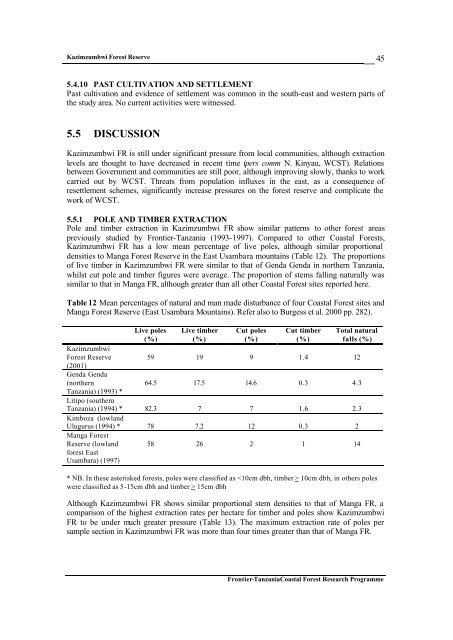Frontier Tanzania Environmental Research REPORT 110 ...
Frontier Tanzania Environmental Research REPORT 110 ...
Frontier Tanzania Environmental Research REPORT 110 ...
You also want an ePaper? Increase the reach of your titles
YUMPU automatically turns print PDFs into web optimized ePapers that Google loves.
Kazimzumbwi Forest Reserve<br />
45<br />
5.4.10 PAST CULTIVATION AND SETTLEMENT<br />
Past cultivation and evidence of settlement was common in the south-east and western parts of<br />
the study area. No current activities were witnessed.<br />
5.5 DISCUSSION<br />
Kazimzumbwi FR is still under significant pressure from local communities, although extraction<br />
levels are thought to have decreased in recent time (pers comm N. Kinyau, WCST). Relations<br />
between Government and communities are still poor, although improving slowly, thanks to work<br />
carried out by WCST. Threats from population influxes in the east, as a consequence of<br />
resettlement schemes, significantly increase pressures on the forest reserve and complicate the<br />
work of WCST.<br />
5.5.1 POLE AND TIMBER EXTRACTION<br />
Pole and timber extraction in Kazimzumbwi FR show similar patterns to other forest areas<br />
previously studied by <strong>Frontier</strong>-<strong>Tanzania</strong> (1993-1997). Compared to other Coastal Forests,<br />
Kazimzumbwi FR has a low mean percentage of live poles, although similar proportional<br />
densities to Manga Forest Reserve in the East Usambara mountains (Table 12). The proportions<br />
of live timber in Kazimzumbwi FR were similar to that of Genda Genda in northern <strong>Tanzania</strong>,<br />
whilst cut pole and timber figures were average. The proportion of stems falling naturally was<br />
similar to that in Manga FR, although greater than all other Coastal Forest sites reported here.<br />
Table 12 Mean percentages of natural and man made disturbance of four Coastal Forest sites and<br />
Manga Forest Reserve (East Usambara Mountains). Refer also to Burgess et al. 2000 pp. 282).<br />
Live poles<br />
(%)<br />
Live timber<br />
(%)<br />
Cut poles<br />
(%)<br />
Cut timber<br />
(%)<br />
Total natural<br />
falls (%)<br />
Kazimzumbwi<br />
Forest Reserve 59 19 9 1.4 12<br />
(2001)<br />
Genda Genda<br />
(northern<br />
64.5 17.5 14.6 0.3 4.3<br />
<strong>Tanzania</strong>) (1993) *<br />
Litipo (southern<br />
<strong>Tanzania</strong>) (1994) * 82.3 7 7 1.6 2.3<br />
Kimboza (lowland<br />
Ulugurus (1994) * 78 7.2 12 0.3 2<br />
Manga Forest<br />
Reserve (lowland<br />
forest East<br />
Usambara) (1997)<br />
58 26 2 1 14<br />
* NB. In these asterisked forests, poles were classified as 10cm dbh, in others poles<br />
were classified as 5-15cm dbh and timber > 15cm dbh<br />
Although Kazimzumbwi FR shows similar proportional stem densities to that of Manga FR, a<br />
comparison of the highest extraction rates per hectare for timber and poles show Kazimzumbwi<br />
FR to be under much greater pressure (Table 13). The maximum extraction rate of poles per<br />
sample section in Kazimzumbwi FR was more than four times greater than that of Manga FR.<br />
<strong>Frontier</strong>-<strong>Tanzania</strong>Coastal Forest <strong>Research</strong> Programme

















